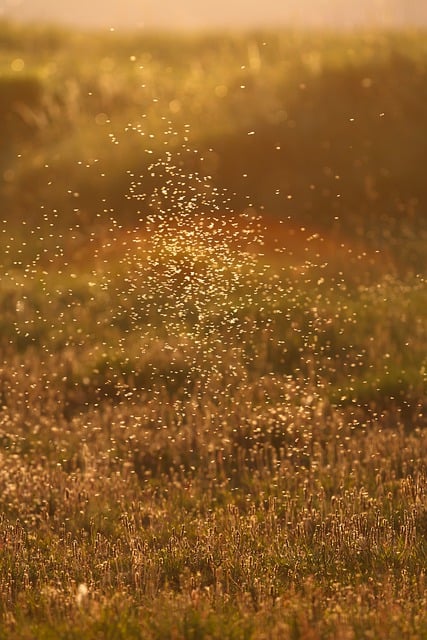Understanding mosquito breeding sites is crucial for effective pest management. Eco-friendly source reduction methods, such as eliminating standing water in buckets, tires, and clogged gutters, disrupt breeding cycles. Advanced technologies like thermal imaging cameras and drone surveillance aid in identifying hidden water sources, while manual inspections with magnifying glasses confirm species and water quality. Implementing holistic strategies that consider site proximity to habitats enables targeted eco-friendly mosquito solutions, including removing water from garden features, using natural repellents, community education, and eco-traps, fostering balanced ecological conditions without disrupting local ecosystems.
Mosquitoes are a persistent nuisance, but they also pose significant health risks. To combat this, thorough inspections are key in identifying breeding sites and implementing effective, eco-conscious solutions. This article explores an eco-friendly approach to understanding mosquito breeding grounds, providing comprehensive inspection methods, step-by-step guides for risk assessment, and post-inspection control measures that prioritize environmental safety. Discover how to minimize these pests without compromising nature’s balance.
Understanding Mosquito Breeding Sites: The Eco-Friendly Approach
Understanding Mosquito Breeding Sites: The Eco-Friendly Approach
Mosquito breeding sites are often overlooked, yet they play a critical role in managing and controlling mosquito populations. These sites, typically standing water bodies like buckets, tires, clogged gutters, or stagnant pools, serve as perfect incubators for mosquito larvae. By identifying and eliminating these breeding grounds, we can significantly reduce the mosquito population and minimize the risk of disease transmission.
Adopting eco-friendly mosquito solutions is not just a sustainable choice but also an effective one. Instead of relying on chemical pesticides, which can harm the environment and beneficial insects, focusing on source reduction offers a more holistic approach. This involves properly disposing of or emptying containers that collect water, maintaining good drainage systems, and using natural predators like fish or birds to control larvae in bodies of water that cannot be easily drained. These methods not only reduce mosquito populations but also contribute to a healthier, more balanced ecosystem.
Methods for Comprehensive Inspections: Tools and Techniques
Comprehensive inspections for identifying mosquito breeding sites involve a multi-faceted approach that combines both advanced technology and traditional methods. Public health professionals often use thermal imaging cameras to detect warm, standing water—ideal conditions for mosquito larvae—that might be hidden from plain sight. Drone surveillance is another powerful eco-friendly mosquito solution, offering aerial views that can pinpoint small bodies of water in hard-to-reach areas.
Manual inspections with magnifying glasses and containers for sample collection are still crucial. Trained personnel can identify specific mosquito species by their larvae and pupae, as well as assess the quality and volume of water. This hands-on approach also allows for the examination of potential breeding sites’ proximity to human habitats, helping to prioritize areas for intervention with eco-friendly mosquito solutions.
Identifying Potential Risks and Safe Spaces: A Step-by-Step Guide
Identifying potential risks and safe spaces is a crucial step in implementing thorough inspections for mosquito breeding sites. Start by assessing your surroundings, focusing on areas with stagnant water as mosquitoes breed rapidly in such environments. Check for any discarded containers, old tires, bird baths, or clogged gutters that can accumulate water. These are common breeding grounds and should be addressed immediately to disrupt the mosquito life cycle.
Next, consider implementing eco-friendly mosquito solutions. Remove or empty standing water from garden features like ponds or fountains that aren’t actively used. Install mosquito traps or use natural repellents like citronella plants or lavender to create safe spaces outdoors. Regularly inspect and maintain these areas to ensure they remain free from mosquito habitats, promoting a healthier environment for both humans and local ecosystems.
Implementing Effective, Eco-Conscious Control Measures Post-Inspection
After identifying mosquito breeding sites through thorough inspections, it’s crucial to implement effective and eco-conscious control measures. Opting for eco-friendly mosquito solutions not only minimizes environmental impact but also promotes long-term sustainability. Natural repellents, such as citronella plants or essential oils, can deter mosquitoes without harming local ecosystems. Additionally, removing standing water from areas like buckets, flower pots, or clogged gutters significantly reduces breeding grounds.
Community engagement plays a vital role in post-inspection control efforts. Educating residents about the importance of regular inspections and proper waste management encourages collective action. Encouraging the use of eco-friendly mosquito traps and larvicides, which target specific pests without affecting non-target species, further enhances the effectiveness of these measures. By integrating these strategies, communities can effectively manage mosquito populations while preserving the balance of their local ecosystems.
In conclusion, implementing thorough inspections to identify mosquito breeding sites is a crucial step towards adopting eco-friendly mosquito solutions. By understanding the environmental factors that facilitate breeding, utilizing appropriate tools and techniques for comprehensive inspections, and following a step-by-step guide to mitigate risks, communities can effectively manage mosquito populations while minimizing environmental impact. Post-inspection, adopting eco-conscious control measures ensures a balanced approach that protects both public health and the ecosystem, fostering a sustainable and harmonious environment.
